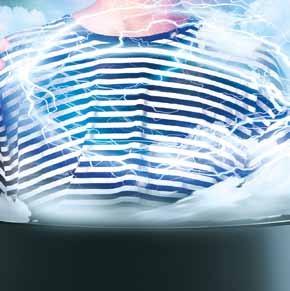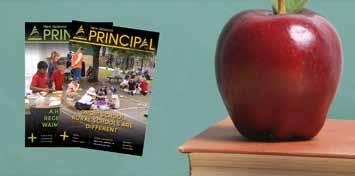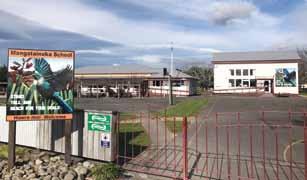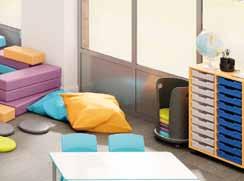
18 minute read
DANce StuDIeS – DANce AND pOLItIcS, LeADerSHIp AND INcLuSION
Experience with young children helps, but is not necessarily the sole driver for an appointment. The new entrant teacher needs to be personable, organised, and committed. They will be constantly dealing with parents, more so than most other teachers in the school. They are also the first step forward from early childhood education into the New Zealand Curriculum. What happens in the new entrant room can set children up for their entire schooling journey.
6. The year Six or year Eight Teacher: The last year at a primary school is a very special time. The children are the seniors of the school. They hold a special place in setting student culture and providing student leadership. It is a pivotal time for them. Parents are very aware of this. They want the final year for their child to be successful. That final year comes with a wide range of extracurricular opportunities that a good senior teacher will tap into for the betterment of the children. A strong teacher, expert at Level Three and Four of the New Zealand Curriculum, adept at management, organised and confident, is a strong contributor to school culture and fosters student leadership. Such teachers can make the final year at a primary school a very positive and memorable year for the students that parents really appreciate.
7. The Parent body Chair: Parents are vital to a successful school. Their formalised interaction often comes through a PTA, Home and School or Friends of the School. Such bodies support the school in events and provide additional funds through fundraising. A healthy parent body can add a dimension of positivity and nurturing to the school.
Having a good chair, who understands the role, is refreshing. A good chair will steer parents away from the negativity that can breed at the school gate. A good chair understands that governance happens with the BOT and management happens with the Principal. A good parent body chair is so uplifting to have, as they maximise the power of parents to come in behind the school and encourage and grow it.
It is a healthy exercise to be conscious of the synergetic connections that comprise a school. Whilst all seven are crucial I have deliberately ordered them as I have, because that is how I see their significance to the health and organisation strength of a school.
Reflect on your school. How do you see it? What order would you put them in? Are there other positions you would include? Are there some that you would leave out?
The key point is ensuring that in our schools the right people, are in the right place, at the right time, thinking the right way, and doing the right things. Whatever the size of the school, we cannot leave the appointment of people to crucial positions to an accident of serendipitous chance.
Clarity gives wisdom that informs conscious actions.
When we get this right, the children benefit from a school that is focused upon them and their needs.
The Challenger 1000
Portable PA system with stand and wireless microphone
For sports, Assembly, Jump Jam and performances.
Best sounding portable PA in New Zealand. Fully featured, top quality and easy to use. Includes a weather cover for outdoor use.
Built-in trolley and powerful rechargeable batteries so you can take it anywhere. $1995+gst for the wireless PA system
$1995 + gst
School Bells and Buzzers
Made in the USA
With the built-in remote scheduling function on the Netbell products, it is super easy to expand your timed alert and school bell system. • Control and program your bells easily from a PC • Simple to set up and program • Easily extendable • Free software is only needed to set up the schedule – doesn’t need a dedicated PC
Call Now 0800 433927 sales@edwardsnz.co.nz edwardsnz.co.nz
Help students cope when everything gets shaken up







Teach your class how to find calm in an emotional storm.


Pause Breathe Smile is a mind health programme designed for New Zealand primary and intermediate school children, proudly funded by Southern Cross. Research shows it increases wellbeing, reduces stress and boosts conflict resolution skills. Enquire online to book your school’s PLD www.pausebreathesmile.nz

thE gEl in thE PEll mEll: thE EmErging rolE oF thE PErForming artS tEachEr in an Era oF maSS migration
professor Nicholas rowe ProFESSor in dancE StudiES at thE univErSity oF auckland
Teaching Identity Learning performing arts is not just preparation for life on the stage. Dance, Drama and Music provide us with a space to creatively interact with each other, allowing us to re-imagine the world around us. Recognizing this potential, successive arts education policies have emphasized the need to ‘apply arts education principles and practices to contribute to resolving the social and cultural challenges facing today’s world’i. It is important to distinguish these two types of challenges, social and cultural, in relation to the role of the arts teacher. While there has been much discussion on arts education for social transformation, the role of arts education in cultural transformation also requires attention. Leading creative interactions towards culturally constructive outcomes is not a straightforward teaching enterprise, and can require pedagogic skills and dispositions that contrast with historic expectations of dance, drama and music teachers. As cultural pluralism encourages learners to bring increasingly diverse expectations into an arts classroom, the intercultural competence of arts educators has become a core concern. Fostering collaborative interactions amongst a culturally diverse group of learners can require more than just an expanded curriculum: it can demand an expanded understanding of teaching identity.
Within this article I argue that debates on the performing arts teacher’s identity need to move beyond the stale contrasts between the ‘sage on the stage’ and the ‘guide on the side’, and focus instead on their role as an agent of cultural integration, or what might be called the ‘gel in the pell-mell’. The socializing actions of a dance, drama or music teacher can transform a crowd into a community: they can move a room full of self-interested individuals into a collectively-curious cohort, fascinated by the social capital of their emerging society. For this society to effectively remain pluralistic and accommodate cultural diversity however, the teacher that is ‘gelling’ their interactions needs to continually reflect on how culture is being valued. why is this such an urgent matter? People are moving, faster than ever before, and not by choice. The UN estimates that currently 70 million people have been forcibly displaced as a result of political, economic or environmental
catastrophes, and every 2 seconds another individual is set upon the road. By the year 2050, there may be up to 1 billion climate refugees globally, or one in every nine persons. The Oceanic region is experiencing the world’s highest migration, by proportion of population, largely propelled by economic inequities and environmental disastersii. Through the SOCIALIZING this migration, we might anticipate that Aotearoa New Zealand will continue to ACTIONS OF A dANCE, grow in both its population density and dRAMA OR MuSIC its cultural diversity. In ten year’s time, the cultural demographics of learners in our TEACHER can transform classrooms will appear significantly different than they did ten years ago. How might a CROwd INTO A this increasing acculturation (the coming COMMuNITy . . . together of different cultural values and practices) present expectations and choices for education, and for the role of the teacher? Managing Acculturation Throughout history, acculturation has been approached in different ways, often through segregation (the deliberate partitioning of cultural, social and political practices amongst different cultural groups who are inhabiting the same geographic space) and assimilation (the disempowering of particular cultural practices and values so that individuals and groups are forced to adapt themselves to fit in to a dominant cultural group). Both cultural segregation and cultural assimilation have been extensively critiqued for contributing to social, political and economic inequities, for marginalizing disempowered communities, and for sectarian violence. The concept of cultural integration (the hybrid construction of a more complex and varied culture) has been advanced within global governance policies as an alternate approach to acculturation. Integrating diverse cultural ideals and practices is valued as a means of fostering more tolerant, pluralist societies, but means that we need to challenge ethnocentric assumptions about cultural superiority. Through cultural integration, societies can both support decolonization, and challenge the ultra-right imaginings of nationhood that seek to devalue and exclude cross-cultural influences. It can feel comfortable to assume that cultural integration occurs naturally, as a result of human curiosity in moments of cultural exchange, and that we do not really need to do anything except just let it happen. Unfortunately, dominant social frameworks and institutions can maintain a power bias that
explicitly or implicitly values one culture over another, impeding (or at least slowing) effective processes of cultural hybridity. Formal education systems therefore have an important role to play in proactively fostering cultural integration. This involves more than the just the placement of cultural products side-byside: the tokenistic cultural fairs/performance evenings that are commonly used by schools to evidence their multiculturalism and inclusion. For cultural integration to be activated within schools, learners need to feel encouraged to sensitively identify points of cultural synergy and contrast, and to feel empowered to make critical decisions about these cultural ideas, in ways that lead to more complex manifestations of culture.
While the diversification of cultural concepts within formal curricula has opened these possibilities, it has also led to identitydilemmas for teachers, who can feel that they do not have the authority, or possibly the inclination, to represent and promote such different cultural ideas. Postgraduate research projects that I have supervised have examined this phenomenon in dance education, noting the sense of bewilderment that teachers can experience when called upon to lead learning into culturally unfamiliar territoryiii. Their research has also revealed how the inclusion of indigenous cultural content can be hopelessly tokenistic, and the problems that emerge when the cultural learning is decontextualized to fit neoliberal paradigms of educationiv. This has led to further research that has explored how indigenous Pacific teaching-and-learning practices might be recognized and valued within formal education contextsv . Our research in Dance Studies suggests that the teacher’s role, as an agent of cultural integration, remains an ambiguous ideal that requires further research and unpackingvi . Teachers as agents of cultural integration The role of a teacher as an agent of cultural integration is a relatively new idea, and contrasts markedly with more traditional functions of a teacher: to assimilate learners into the dominant cultural and knowledge practices of a community, or to effectively assess and segregate learners according to their abilities. To be an agent of cultural integration, the teacher’s fundamental role is to recognize and celebrate the diversity in the classroom, and to encourage learners to experiment with this diversity for the purpose of constructing new, hybrid cultural forms. As an agent of integration, the knowledge authority that a teacher might possess on a particular cultural history becomes a less important pedagogic asset. In its place, their ability to recognize ethnocentric assumptions and motivate equitable and collaborative cross-cultural relationships becomes a core skill.
In this sense, the role of a teacher as an agent of integration is more akin to that of a community animateur: someone whose pedagogy is focused not on advancing particular knowledge acquisition, but on using learning as a mechanism for generating ideas that are relevant to a particular community. This hyperconstructivist approach to pedagogy relies upon an ability to foster promotive peer relationships amongst learners, in ways that deeply value equity and diversity. Through the growth of such social interdependence, students may then enter more collaborative mindsets, valuing the complexity of difference over the measurement of conformity.
While this sounds all very idealistic, engaging in such a teaching practice, and finding room for it in the curriculum, is by no means straightforward. My research in this area expanded with colleagues in Scandinavia, investigating teacher training courses for Physical Education teachers in Finland in 2016vii. As Europe was grappling with the largest refugee crisis that it had experienced in almost a century, the issue of acculturation, and the role of teachers within it, had become an urgent concern. The PE curriculum has expectations that learners socialize in very physically interactive ways. This can foreground very differing cultural expectations of physicality, particularly cultured understandings of gender. We identified that PE teachers were increasingly expected to navigate significant cultural differences in the classroom, in extremely tangible ways that were perhaps not so apparent in less physical and experiential learning environments. These PE teachers had received very little preparation in how to effectively manage cross-cultural interactions, and their teacher-training processes generally led them to default practices of cultural assimilation: working out ways to convince migrant children from very diverse cultural backgrounds how to ‘fit in’ with local cultural norms. While we acknowledge the pragmatics of such an approach, we were made increasingly aware of the risks that this posed to the learner’s sense of belonging, the teacher’s sense of cultural purpose, and the wider community’s longer-term prospects of becoming a culturally integrated society.
The gel in the pell-mell Like Physical Education, performing arts classrooms can require a high degree of experiential, sense-based interaction between learners. Dance, drama and music classes also foreground ideals of culture and creativity, emphasizing a learner’s potency to make innovative artistic and aesthetic choices, in ways that extend on the cultural choices made by others in current and previous
MAGAZINE
You can now access the current and past issues of NZ Principal magazine online

You can search by magazine issue, article name or author
visit www.nzprincipal.co.nz
continued on pg 34
Mangatainoka School was established in 1889 and is a small rural school situated between Woodville and Pahiatua in the Tararua District that educates students between years 0-8. Recently the schools Principal, Mr Jason Edwards, recognised the need to further enhance the protection of the school assets, its student community and its staff. After an evaluation of acceptable solutions, Edwards chose to install an Inner Range access control and security system, in conjunction with a Hikvision IP video camera system. Edwards engaged a local company, Couchman Alarms based in Palmerston North, to undertake their design and installation. With school upgrade work soon to be carried out, we discussed why Mangatainoka School and Mr Edwards chose these solutions.
Q: What was the main reason for having a Security & Surveillance system installed?
A: We are looking to future proof our school as we are continually updating and adding assets to our digital capability in school. We have not had many issues with theft or vandalism but want to ensure the safety and protection of our people and property as we look to the future.
Q: Why did you choose Couchman Alarms?
A: Couchman Alarms was highly recommended by a neighbouring school and they are known for their professionalism and high quality products. Couchman’s provided a full and comprehensive quote with the Inner Range features explained fully, which is definitely going to provide the features we want now and into the future as expansion is required.
Q: What made you decide to use the Inner Range Inception system and Hikvision CCTV?
A: Having access to the system remotely via an app was a big plus for us - being able to control, view and review events is fantastic when you don’t live right next door. In the current global climate we felt it was vital to be able to monitor our school site even if we were not able to physically visit the site. Being a smaller rural school, budget is always a factor with every decision. We found the cost effectiveness for what we wanted to be able to do with the system very good.
Q: With the recent events spotlighting privacy protection and cyber security, how important are these to a school board?
A: Protecting our student and staff communities through identifying best in class cyber and privacy protection is now at the core of our digital asset procurement. We were impressed by the demonstrable methodologies, such as two factor authentication when accessing systems and the 128bit AES encryption of data across networks. These attributes supported our decision when selecting Inner Range and Hikvision to meet our requirements. In summary, Couchman Alarms has consulted with Mr Edwards to address the security concerns at Mangatainoka Primary School and has provided a state of the art solution that can be expanded in the future whilst meeting the budgetary constraints of the school. Providing remote access to control the Inner Range Inception system and receiving notifications of alarms to their mobile phones then allows the schools staff to log into the Hikvision camera system and evaluate the situation all in the palm of their hand using the Hik-Connect mobile application.

COMPLETE SCHOOL SECURITY IN THE PALM OF YOUR HANDS
l t r o n o C e t R e m o










Our School
Alarm on entry door
5.02PM
n i o i i c a t t o N m A l a r o n i i c a t V e r i s u a l V i
Protecting school staff, students and assets for more than 30 years
generations. Such a mix of high social interaction, creative exploration and cultural referencing makes performing arts classes the ideal location to experiment with cultural integration. In a society that is rapidly acculturating, this presents more than an opportunity for performing arts teachers: it presents a responsibility.
So, what are the competencies required of such a teacher? Obviously, the inclination to be the ‘gel in pell-mell’ remains central: the ability to pro-actively animate promotive peer relationships that allow for sensitive and equitable collaboration. Recognizing the underlying cultural hierarchies that exist within formal education, it is also of critical importance that a dance, drama or music teacher can recognize their own ethnocentricity (in pedagogy and content). Such reflections can foster more ethno-relative understandings of culture, and help learners to transition from tolerating, to celebrating, to actively integrating cultural differences. Training such competencies and inclinations in dance, drama and music teachers is ultimately the responsibility of tertiary education, but allowing such teachers to subsequently thrive is the responsibility of principals and curriculum writers.
Ultimately, this first involves acknowledging the socio-political significance of performing arts teachers as agents of cultural integration.
AbOut tHe AutHOr Professor Nicholas Rowe is a Professor in Dance Studies at the University of Auckland and UNESCO Chair in Dance and Social Inclusion. He is an award-winning filmmaker and has authored several books on dance and marginalized communities. Prior to joining academia, he worked for two decades as a community animateur in refugee camps in Asia and the Middle East.
refereNceS
i UNESCO 2011. Seoul Agenda for Arts Education. Available at: http://www.unesco.org/new/fileadmin/MULTIMEDIA/HQ/
CLT/CLT/pdf/Seoul_Agenda_EN.pdf ii UN 2020. World Migration Report. Available at: https://publications.iom.int/system/files/pdf/wmr_2020.pdf iii Ashley, L. (2012). Dancing with difference: Culturally diverse dances in education. Springer Science & Business Media.
Reihana – Morunga T. (2020). Classroom Kōrero: relationships and the delivery of Māori content in the New Zealand secondary school dance class. Research in Dance Education, 1-17.
iv Mabingo, A. (2020). Ubuntu as Dance Pedagogy in Uganda.
Springer Singapore. v Ofamo’oni, J., & Rowe, N. (2020). The Māfana Framework: how
Pacific students are using collaborative tasks to decolonize their learning. Higher Education Research & Development, 1-15. vi Mortimer, K. (2020). Finding common ground: Dance studio teachers’ responses to cultural difference within rural towns in
Aotearoa (Doctoral dissertation, ResearchSpace@ Auckland). vii Antilla, E, Siljamaki, M & Rowe, N. (2018). ‘Teachers as
Frontline Agents of Integration: Finnish Physical Education
Students’ Reflections on Intercultural Encounters’. Physical
Education and Sport Pedagogy 23 (6), 609-622.


Proudly 100% Kiwi owned and operated, we are leaders in innovative learning environments. Specialising in quality Sebel and New Zealand made furniture, we offer a wide range of products for all learning spaces, administration areas, and specialist areas. We can help you with entire school fit-outs, listening to what you need and delivering your vision.
Visit us online @ sebeldistinction.net.nz or for a FREE consultation call 09 523 4092





